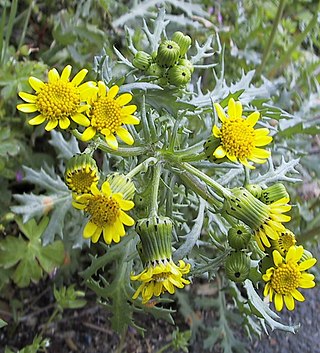
Senecio is a genus of flowering plants in the daisy family (Asteraceae) that includes ragworts and groundsels.

Senecio vulgaris, often known by the common names groundsel and old-man-in-the-spring, is a flowering plant in the family Asteraceae. It is an annual herb, native to the Palaearctic and widely naturalised as a ruderal species in suitable disturbed habitats worldwide.

The cinnabar moth is a brightly coloured arctiid moth found as a native species in Europe and western and central Asia then east across the Palearctic to Siberia to China. It has been introduced into New Zealand, Australia and North America to control ragwort, on which its larvae feed. The moth is named after the red mineral cinnabar because of the red patches on its predominantly black wings. The species was first described by Carl Linnaeus in his 1758 10th edition of Systema Naturae. Cinnabar moths are about 20 mm (0.79 in) long and have a wingspan of 32–42 mm (1.3–1.7 in).

Packera is a genus of about 75 species of plants in the daisy family, Asteraceae. Most species are commonly called ragworts or grounsels. Its members were previously included in the genus Senecio, but were moved to a different genus based on chromosome numbers, a variety of morphological characters, and molecular phylogenetic evidence.

Packera obovata, commonly known as roundleaf ragwort, spoon-leaved ragwort, roundleaf groundsel, or squaw-weed, is an erect perennial herb in the Asteraceae (aster) family native to eastern North America. It was previously called Senecio obovatus. Basal and lower leaves are obovate with toothed margins, while upper leaves are pinnately divided. The ray flowers are yellow and the disk flowers orange-yellow, the inflorescences being held well above the foliage.

Senecio cambrensis is a flowering plant of the family Asteraceae. It is endemic to Great Britain and currently known only from North Wales. It is a recently evolved plant that arose as a result of hybridization between two related species.

Packera aurea, commonly known as golden ragwort or simply ragwort, is a perennial flower in the family Asteraceae.

Senecio ampullaceus, also known as Texas ragwort, Texas squaw-weed, Texas groundsel, and Texas butterweed, is a species of Senecio in the family Asteraceae, receiving its Latin name ampullaceus from its flask shaped flower-head. It is recommended for landscape use in its native Texas.

Senecio viscosus is a herbaceous annual plant of the genus Senecio. It is known as the sticky ragwort, sticky groundsel or stinking groundsel.

Senecio squalidus, known as Oxford ragwort, is a flowering plant in the daisy family Asteraceae. It is a yellow-flowered herbaceous plant, native to mountainous, rocky or volcanic areas, that has managed to find other homes on man-made and natural piles of rocks, war-ruined neighborhoods and even on stone walls. These habitats resemble its well drained natural rocky homeland. The plants have spread via the wind, rail and the activities of botanists. The travels of this short-lived perennial, biennial, or winter annual make it a good subject for studies of the evolution and ecology of flowering plants.
Ragwort may refer to a number of plant species:

Senecio flaccidus, formerly recorded as Senecio douglasii, member of the daisy family and genus Senecio also known as threadleaf ragwort, is a native of the southwestern Great Plains of North America.

Tephroseris palustris, also known by its common names swamp ragwort, northern swamp groundsel, marsh fleabane, marsh fleawort, clustered marsh ragwort and mastodon flower, a herbaceous species of the family Asteraceae. It can be seen most easily when its bright yellow umbel flowers appear from May to early July standing 3 to 4 feet along marshes, stream banks and slough areas where it likes to grow.

Packera paupercula is a flowering plant species of the genus Packera and family Asteraceae, native to North America, where it is widespread across Canada and much of the United States. Its common names include balsam ragwort and balsam groundsel. It is a perennial herb that grows 1–3 feet tall. Its habitats include wet meadows, open woodlands, and rocky outcrops.

Senecio triangularis, known as arrowleaf ragwort, arrowleaf groundsel and arrowleaf butterweed, is a species of the genus Senecio and family Asteraceae.

Senecio aphanactis, known by the common names chaparral ragwort, rayless ragwort, and California groundsel, is a species of flowering plant in the aster family.

Senecio integerrimus is a species of flowering plant in the aster family known by the common names lambstongue ragwort and tall western groundsel. It is native to western and central North America, where it grows in grassland, forest, and other habitat. It is a biennial or perennial herb producing one or a few erect stems 20 to 70 centimeters tall from a caudex with fleshy shallow roots. The linear to lance-shaped or triangular leaves are primarily basal, with blades up to 25 cm (10 in) long. The herbage is slightly hairy to woolly or cobwebby. The inflorescence bears several flower heads in a cluster, the middle, terminal head often largest and held on a shorter peduncle, making the cluster look flat. The heads contain many disc florets and usually 8 or 13 ray florets which may be yellow to cream to white in color. Some heads lack ray florets.

Packera franciscana is a rare species of flowering plant in the aster family known by the common name San Francisco Peaks groundsel, or San Francisco Peaks ragwort. It is endemic to Arizona in the United States, where it is known only from the San Francisco Peaks in Coconino County. It is threatened by recreational activities in its habitat. It is a federally listed threatened species of the United States.

Packera musiniensis is a rare species of flowering plant in the aster family known by the common names Musinea ragwort and Musinea groundsel. It is endemic to Utah in the United States, where it is known only from Sanpete County in the Manti-La Sal National Forest.




















